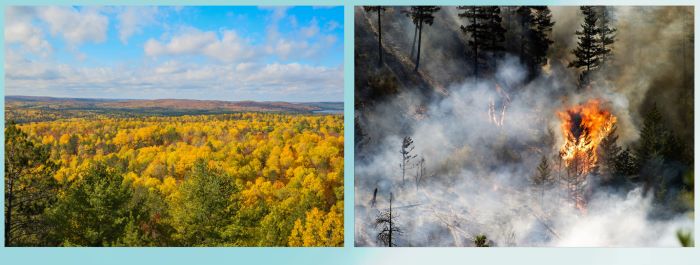Imagine trying to measure something that’s invisible when conditions are changing every day. Yet keeping track of greenhouse gas emissions is increasingly important in our rapidly changing world. Discover how Natural Resources Canada’s highly skilled carbon accounting team calculates these complex estimates for all of Canada’s forests.
June 2023
While many people know that estimating and reporting greenhouse gas (GHG) emissions from Canada’s forest sector is important for tracking progress toward the country’s net-zero commitment, few know how it’s done. We can’t put forests in a sealed box to measure the rise and fall of GHGs. So how exactly does NRCan’s team of experts estimate the emissions in Canada’s immense forest sector?
There’s no one, simple approach. Even the highest-resolution satellites can’t reveal every slight change in GHGs in every corner of Canada’s vast 226 million hectares of managed forest. And the numbers can vary wildly from year to year as natural disturbances such as wildfires are more extreme in some years than others. Forest carbon accounting is complicated, but it’s the kind of challenge the Canadian Forest Service (CFS) carbon accounting team takes on every day.

Global climate change presents a significant risk to Canadian forests. One thing is clear: the future will not be like the past. (Photos: iStock)
A growing sense of urgency
Tracking and reporting emissions in a scientifically consistent way is crucial because it’s the only way to manage them. When GHGs are released into the atmosphere, they trap heat that changes our climate in multiple ways. And the temperature is rising: according to Canada’s Changing Climate Report, Canada is experiencing warming at about double the global rate. And forested areas in particular are susceptible to climate change–induced mortality due to insect and wildfire impacts as seen in many of our forests.
Yet we are committed to addressing the problem. Canada signed on to the United Nations Framework Convention on Convention Climate Change (UNFCCC) in the 1990s and pledged to report emissions annually following the good-practice guidance developed by world-leading experts selected by the Intergovernmental Panel on Climate Change (IPCC). The goal of the UNFCCC is a simple one: to stabilize global GHG emissions and then reduce them to a level that would prevent dangerous interference with the global climate.
Finding a delicate balance
Carbon accounting isn’t only about the numbers — especially when it comes to the dynamic nature of Canada’s forests.
“If all you do is look at emission values, you’re missing the whole picture,” says Ben Hudson, who manages the carbon accounting team. “Emissions from one type of activity can have very different impacts on the global climate. For example, fossil fuel production and use will have a different impact compared with forest sector activities and harvested wood products.”
One big distinction is that in the forest sector, harvesting trees can create emission-reduction opportunities. Trees grow back. Some harvested stands regenerate naturally, though many more are restocked when seedlings are planted. Once the seedlings are established, these renewed forests become an effective carbon sink, absorbing carbon dioxide gas (CO2) from the atmosphere, often at rates greater than when they were harvested.

Forest management that effectively uses harvested wood and sustains the productivity and resilience of Canadian forests is essential to mitigating global climate change. Photo left: Brock Commons tallwood building, KK Law; right: seedlings, Nik West (both photos courtesy naturallywood.com)
Forests provide a wide array of benefits to people — including jobs, cultural significance and recreation — and the list of ecosystem benefits is even longer. With Canada’s surging population growth, demand for the wood products needed for housing, commercial buildings and other purposes will continue to increase. Long-lived wood products are more sustainable than other, more carbon-intensive materials such as concrete and steel, because producing wood products emits less carbon. For example, mass timber, which is an engineered wood product used in the construction of a wide range of buildings, is extremely strong and durable. Mass timber buildings store carbon for generations, keeping it out of the atmosphere, and the materials used in their construction can be recycled at the end of use.
The forest and the trees
When it comes to calculating GHG estimates for the Canadian forest sector, the team incorporates various factors: data from tree ring measurements, plot measurements and satellite observations. This information is used to estimate how forests might respond to natural disturbances and human activities, and then it’s incorporated into Canada’s forest carbon budget model. “We have access to credible, scientifically vetted information from federal, provincial/territorial, industry and academic partners,” says Ben.
The field is constantly evolving as scientific and technological breakthroughs occur all the time, making it possible to continuously improve Canada’s forest carbon estimates with the best available data and methods.
NRCan employs a diverse team of experts with decades of experience to support a modern, well-informed and unbiased approach. Their estimates of GHG emissions and removals follow international guidelines and meet the requirements of the annual review by international experts from the UNFCCC that follows the publication of national estimates.
“There’s a lot riding on the accuracy and completeness of our estimates, and also on the availability and accessibility of the information for decision makers,” explains Ben. “The global climate change crisis that threatens our way of life, including the survival of our forests, will not be solved unless we make globally responsible decisions. For many reasons, that means finding the right balance in managing timber harvesting along with efforts to conserve our forests and their biodiversity, consistent with the principles of sustainable forest management.”
In the global context, Canada has an important role. While the country is responsible for only 1.5 percent of global GHG emissions, Canada has nine percent of the global forests, and developed countries like Canada are expected to do the most to cut emissions.
So, the next time you follow a carbon reporting debate on social media or read about the National GHG Inventory Report, think of the huge amount of scientific expertise and the volumes of data that are compiled for these estimates, together with the vital contribution to their creation by NRCan’s Canadian Forest Service and others.
For more information
Climate Change Impacts on Canadian Forests
Canada’s National Forest Inventory
Taking stock of Canada’s forests
Canada’s official greenhouse gas inventory
List of technical and research publications involving the Carbon Budget Model